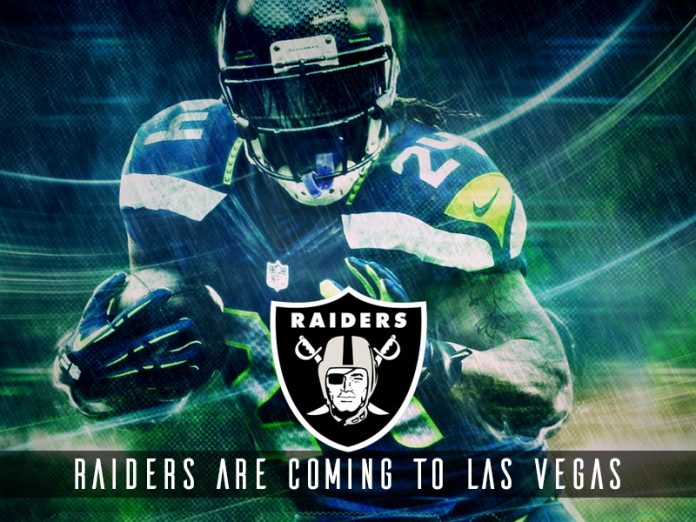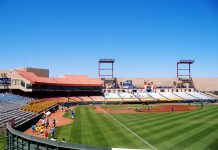It’s official: the Raiders are coming to Las Vegas. Last week, the Silver and Black were approved to relocate to Las Vegas in an NFL ownership vote. The only owner who voted against the Raiders moving was Stephen Ross of the Miami Dolphins. The Oakland Raiders will relocate to Las Vegas from their longtime home in Oakland and begin playing as the Las Vegas Raiders for the 2020 NFL season.
The Raiders got a deal with Las Vegas for a $1.7 billion stadium project that includes $750 million in public funds and Bank of America financing. The Las Vegas public will also foot the bill on infrastructure improvements to accommodate the new stadium.
When the Raiders owner decided to relocate, an attractive plan was built free of any NFL-adverse attachments to Las Vegas gambling interests. Initially, casino magnate Sheldon Adelson was the primary investor but he backed out a few months ago. The team also lost investment firm Goldman Sachs before Bank of America stepped up.
The Las Vegas Stadium will be built on land just off the Strip near I-15 and Russell Road. Once complete, the new stadium will be home to the Las Vegas Raiders and the UNLV football team. This sprawling stadium project is on a tight deadline for completion and it’s been a source of contention for two years.
The new Las Vegas stadium will feature the largest public financial contribution ever made in Nevada to a sports facility at a time when the state struggles at the bottom of the nation in terms of education.
Funding for the stadium includes a $200 million loan approved by NFL owners. This loan is part of the NFL’s G-4 program which is reserved for stadium construction.
The indoor stadium will have seating for 62,500 for most Raiders games but additional seating can be added for the Super Bowl and other major events to bring total seating up to 70,000. To reduce congestion, half of the seating will be at below-ground level. The team will pass through a field-level club to receive cheers from the fans before making their way onto the field.
The stadium will also have some form of an outdoor venue with 80-foot by 120-foot north-facing folding lanai doors for direct views of the Strip. The ceiling of the stadium will be made from a strong translucent polymer that allows natural light into the stadium while keeping the heat to a minimum. This translucent polymer will make the stadium look black during the daytime but lights in the stadium will be visible outside during the night.
Assuming the stadium is completed on deadline, it will be finished on August 1, 2020, just a few weeks before the Raiders host their first exhibition game in Las Vegas. The season will begin in September.
The new venue is already bringing tourism benefits for the city. The sales process recently got underway to Oakland season ticket holders. By mid-March, about 1,100 people had already booked appointments from out of town to fly into Vegas to look at tickets.
The Raiders will continue to play in Oakland for two more seasons as the new Las Vegas stadium won’t be ready until 2020. The team has the option to play at the Oakland Coliseum for 2017 and 2018 which leaves the team in limbo for 2019 but the team owner hopes they can play in the Bay Area for the 2019 season.
This is the second time the Raiders have left Oakland in 35 years. The last time was a relocation to Los Angeles in 1982 before returning to Oakland in 1994 when the city offered to expand its Oakland Coliseum. Oakland is still paying back debt for the 1994 renovations of the Coliseum. The move to Las Vegas comes years after failed attempts to replace or update the Coliseum, which is widely considered as one of the worst NFL stadiums.
Raiders fans are some of the most passionate in the NFL and owner Mark Davis has acknowledged that there will likely be some anger as the Raiders continue to play in Oakland for the next couple of years. Davis has already offered to refund Raiders fans for their season tickets if they do not want them after the team announced its move. Around 1,000 season ticket holders received refunds after the Raiders’ move to Las Vegas was announced. Those tickets were sold to fans within mere hours with all 53,250 season tickets sold out by May.
Only time will tell what the Las Vegas Raiders will mean for the city. Multiple studies have confirmed that stadiums aren’t an effective driver for economic development, but some researchers say that Las Vegas and a few other cities like Orlando are exceptions because they have strong regional tourist economies. Southern Nevada’s current lack of a good venue to attract big special events and concerts has reduced its ability to capitalize on its core strength: sports events and special entertainment.
Las Vegas is expecting strong revenue as tourists and residents buy tickets. The stadium is projected to sell about 45,000 tickets per year. Travel package deals are also predicted to expand into Raiders tickets combined with hotel and casino rates. As Las Vegas is already an international tourist destination, the move will likely be seen as a big win as it currently has almost no NHL and NFL teams. It’s estimated that the Raiders move will add at least 1% to the city’s growing tourist industry.
The local economy may also be impacted by the move. It’s estimated that the Raiders coming to Las Vegas will bring in up to 520,000 new residents in the Las Vegas Valley, potentially increasing home prices and new construction.




